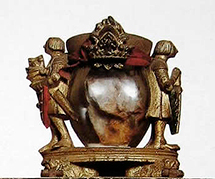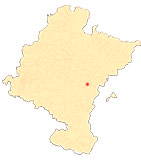The church of Santa María de Ujué
By Ignacio Miguéliz Valcarlos
Heart of Charles II
The will of Charles II that his heart be deposited in Ujué has served over the centuries to justify the link that this king maintained with the sanctuary and to attribute to him the sponsorship of the works carried out in the Gothic period. However, in the successive wills that the monarch granted, in which, following the tradition of the Capetos, he ordered that his body be eviscerated and that his entrails, his heart and his body be deposited in different temples, Ujué is not mentioned. It must have been in the last of them, which has not been preserved, in which he ordered that his body be buried in the cathedral of Pamplona, his entrails sent to Roncesvalles and his heart to Ujué. The person in charge of eviscerating and embalming the body was the Zaragoza physicist Samuel Trigo. The heart, kept in a leaden pichel wrapped in rich gold cloths, arrived at the sanctuary on January 18, 1387, and was placed in the sotacoro. Shortly afterwards, in 1404, Charles III commissioned the master Jaymet to make an oak box to contain the chest with the viscera. This box, still preserved today, was painted red and decorated, was painted red and decorated with the arms of Navarre and the registration "AQVI ESTA EL CORACO DL REY DO KARLES QUI MORIO EN PAMPL LA PMERA NOCHE DE JENERO L AYNO DE LA INCARNATO DE NRO SEYNNNOR ML CCCOS LXXXª ET VI ET RRENO XXXVII AIÑOS ET AVIA LIII AINNOS IIII MESES ET XXII DIAS DIOS POR SU MERCE LI FAGA PERDON AMEN". The heart was placed inside the church, in a niche with the front Closed by an iron grille over the western door, where it remained until 1851 when the Monuments Commission of Navarre decided to dignify it by moving it to the tabernacle of one of the side altarpieces. In 1919, the box was restored and the lead pichel was replaced by an oval glass container, which two years later was placed on a pedestal, framed by two soldiers, supported by four lions. These are a copy of those represented in the reliquary of the Holy Sepulchre of the cathedral of Pamplona. Finally, in 1922, at the request of the Commission of Monuments of Navarre, it was moved to its present location in a niche in the wall of the central apse.
-
CLAVERÍA ARANGUA, J., Historia documentada de la Virgen, del santuario y villa de Ujué, Pamplona, 1953.
-
FERNÁNDEZ-LADREDA AGUADÉ, C., (Dir.), El arte románico en Navarra, Pamplona, 2004.
-
FERNÁNDEZ-LADREDA AGUADÉ, C., and GARCÍA GAINZA, M.ª C., Salve. 700 years of Marian art and devotion in Navarre, Pamplona, 1994.
-
GARCÍA GAINZA, M.ª C., and others, Catalog Monumental de Navarra. III. Merindad de Olite, Pamplona, 1985.
-
LAZCANO MARTÍNEZ DE MORENTÍN, M.ª R., (Coord.), Santa María de Ujué, Pamplona, 2011.
-
URANGA, J. J., Ujué medieval, Pamplona, 1984.











